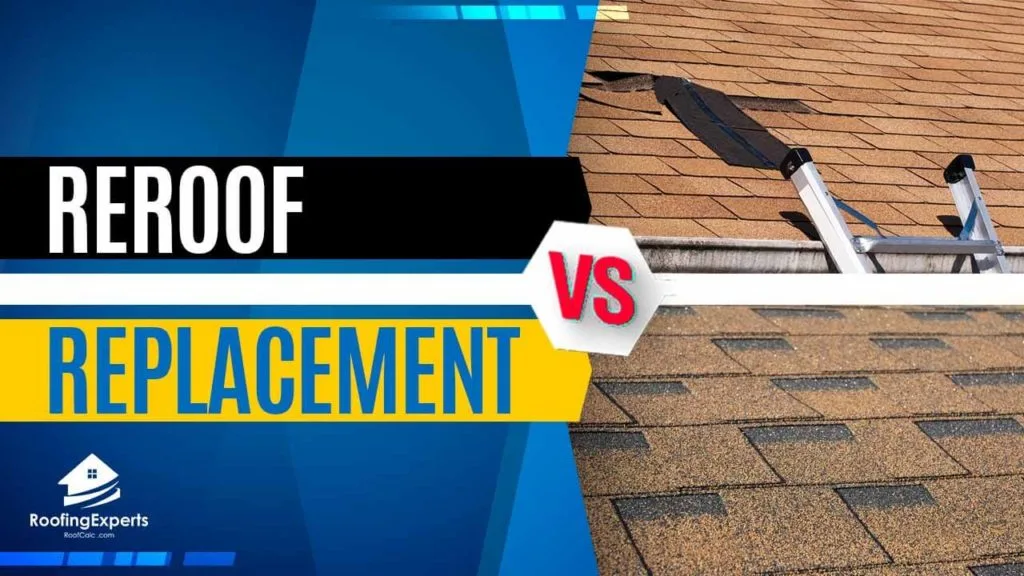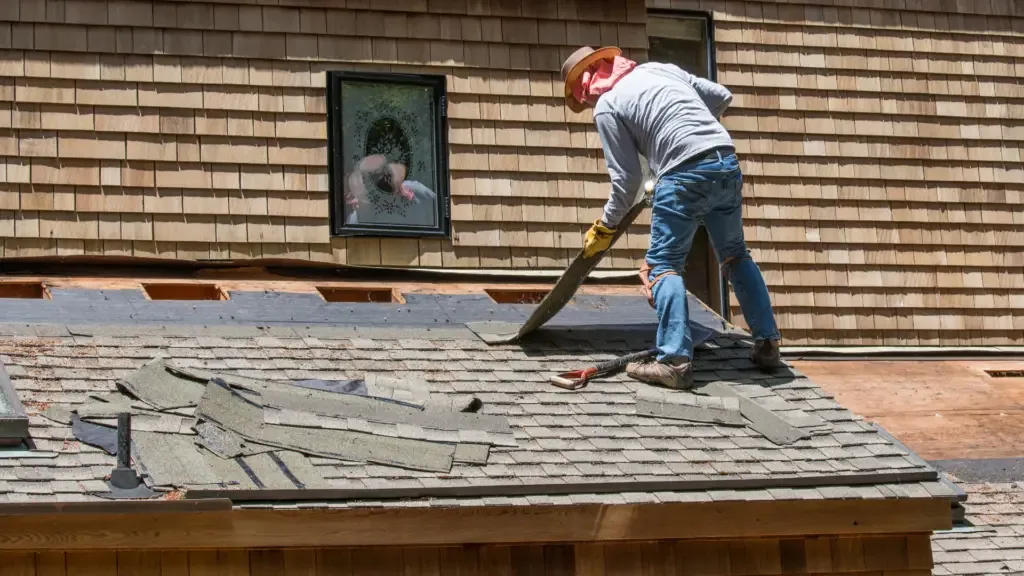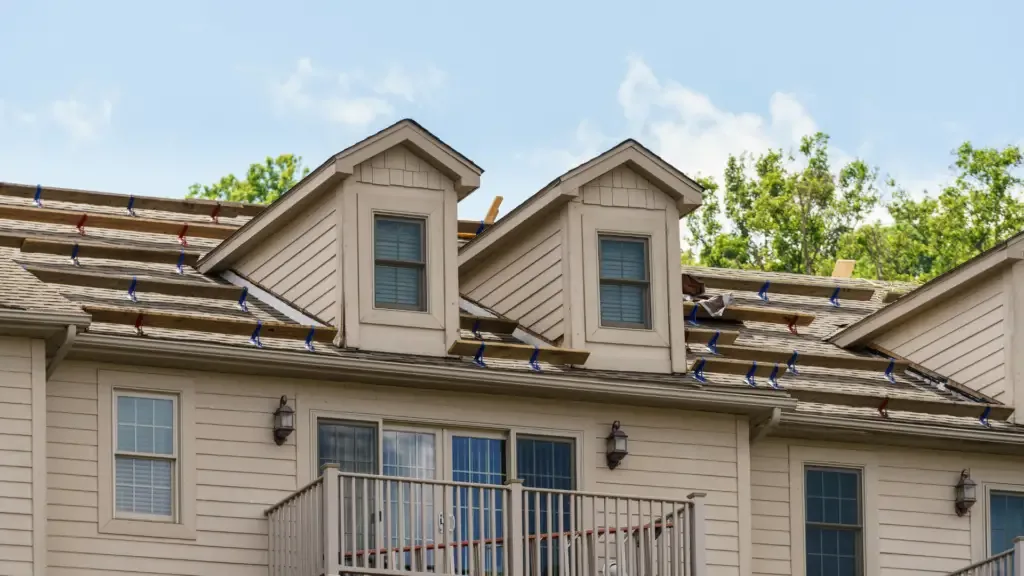
When it comes to fixing or upgrading your roof, you might be wondering if you need a full replacement or just a reroofing.
While the terms are often used interchangeably, they actually refer to two very different processes. In this article, we’ll explore the differences between reroofing and roof replacement, and help you determine which option is right for your home.
By understanding the benefits and drawbacks of each approach, you’ll be able to make an informed decision and ensure that your roof is up to the task of protecting your home for years to come.
Reroofing Vs Roof Replacement: The Basics
What Is Reroofing
Reroofing is the process of laying new shingles over your existing roof. This method is often considered more cost-effective and quicker compared to a full roof replacement.
Reroofing is a viable option if your roof is nearing the end of its lifespan but is still in relatively good condition. A few key points to consider for reroofing:
- Less expensive: Reroofing typically costs around $7,200, which is much lower than the average cost of a full roof replacement ($14,643)
- Faster installation: The process only takes 2-3 days, depending on the complexity of the job
- Environmentally friendly: Reroofing helps keep asphalt shingles out of landfills
Keep in mind, if your roof has more serious issues, such as major leaks or multiple layers of shingles already, reroofing might not be the best option.
What Is Roof Replacement
Roof replacement involves completely removing the existing roof down to the decking and installing a brand new roofing system.
This is a more comprehensive and expensive solution than reroofing but is necessary when the roof has reached its end-of-life or has significant damage. Some points to take note of regarding roof replacements:
- Higher cost: The national average for roof replacement is around $22,000, significantly more than a reroofing job
- A longer process: A roof replacement typically takes longer to complete compared to reroofing
- A fresh start: A new roof will provide better overall protection and increased home value
When deciding between reroofing and a roof replacement, it’s important to evaluate the current condition of your roof, your budget, and your long-term plans for your home.
Consulting with a professional roofing contractor can help you make the best decision based on your specific needs and circumstances.

Factors to Consider
Cost
When deciding between reroofing and roof replacement, it’s important to consider the cost of each option.
Reroofing is typically less expensive than a full roof replacement, as it involves installing new roofing materials over the existing roof without removing the old one. However, the cost of reroofing or roof replacement can vary depending on:
- Labor costs
- House location
- Roofing materials
- Special equipment needed
- Roof accessibility
- House size
Lifespan and Quality
Consider your roof’s age when deciding between reroofing and replacement. Most roofs last 10 to 15 years, or longer, depending on the material and manufacturer. If your roof is nearing the end of its expected lifespan, a full replacement may be a better long-term investment.
Additionally, the quality of the new roofing materials and installation plays a crucial role in determining the performance, durability, and lifespan of your roof.
Weather Conditions and Timing
The weather conditions in your area can significantly impact your decision to reroof or replace. Reroofing might not be the best option in regions with heavy snow or ice, as the added weight can strain the roof structure.
Additionally, consider the best time of the year for the project. Roofing projects can be hampered by inclement weather or extreme temperatures, potentially impacting the quality of the work and the duration of the project.
Slope and Complexity
Your roof’s slope and complexity will also impact the decision between reroofing and replacement. Roofs with a steep slope or intricate architectural features may require more labor and specialized equipment, which can increase the overall cost.
Keep in mind that reroofing may not be possible if the roof’s slope and design are too complex, necessitating a full replacement instead.
Building Codes and Regulations
Finally, consult your local building codes and regulations before deciding between reroofing and roof replacement.
There may be restrictions on the number of roofing layers allowed or other regulations governing roof work. Careful adherence to local codes is essential to avoid potential fines or complications during the project.
Taking these factors into account, you can make a more informed decision between reroofing and roof replacement based on your individual circumstances and preferences.

Signs That You Need a Roof Repair or Replacement
Visible Damage and Leaks
If you notice visible damage to your roof, such as torn or missing shingles, it’s important to address the issue promptly.
Leaks can lead to more significant problems, including water damage and mold growth. Keep an eye out for signs of leakage, such as water stains on your ceilings or walls, and act quickly to repair or replace your roof.
Mold, Rot, and Water Damage
Mold and rot are telltale signs that your roof may need repair or replacement. Check for discolored spots, damp areas, or a musty smell, especially in your attic. Left untreated, mold, rot, and water damage can compromise your roof’s structural integrity and pose a risk to your health.
Curling, Uneven, or Missing Shingles
Curling, uneven, or missing shingles indicate that your roof is experiencing wear and tear. Shingles typically last around 20 years, so if your roof is nearing the end of its lifespan, it may be time to consider repair or replacement.
- Curling shingles: Shingle edges that are curled or cupped need attention
- Uneven shingles: Shingles that are unevenly spaced or misaligned could lead to leaks and other issues
- Missing shingles: Gaps in your roof’s shingle coverage can expose underlying materials to weather damage
Structural Issues, Sagging, and Decking Problems
If you observe sagging or valleys between the rafters, it’s a sign of structural issues and decking problems. This usually means that the roof decking needs to be replaced, which calls for a full roof replacement. Ensure that you inspect your roof and address structural problems before they worsen.
Pests and Other Potential Problems
Keep an eye out for signs of pest infestations, such as rodents or insects, which can damage your roof and cause further issues. Additionally, watch for moss, dark streaks, or algae growing on or between your roofing materials, as these may indicate the early stages of rot or a potential leak.
In conclusion, always perform regular inspections of your roof and be proactive in addressing any signs of damage or deterioration. Repairing or replacing your roof when necessary will help maintain the safety and integrity of your home.

Choosing the Right Materials for Your Roof
Asphalt Shingles
Asphalt shingles are a popular choice for roofing materials due to their affordability and ease of installation. They come in a variety of colors and styles, allowing you to customize the look of your roof.
However, they may not be as durable as other materials, typically lasting 15 to 30 years. When selecting asphalt shingles for your roof:
- Consider the climate of your area
- Choose a color that complements your home’s exterior
- Opt for quality products to ensure longer lifespan and lower maintenance
Metal Roofing
Metal roofing is a durable and environmentally-friendly choice. It comes in various materials, such as galvanized steel, aluminum, copper, zinc, and stainless steel. Metal roofing can last up to 50+ years with proper maintenance. Some factors to consider when choosing a metal roof:
- Determine your budget, as certain metals can be more expensive
- Consider the style and architecture of your house
- Be aware that metal roofs may require specialized installation
Clay, Slate, and Other Materials
Clay and slate are premium roofing materials, known for their long-lasting, weather-resistant properties. These materials can last over 100 years with proper care. Factors to consider when selecting clay or slate for your roof:
- Be prepared for a higher upfront cost
- Ensure your home’s structure can support the added weight
- Work with a professional installer experienced in handling these materials
Other roofing options include wood shakes or cement tiles, which can also offer unique aesthetics and varying degrees of durability. Keep in mind your specific needs, budget, and climate when selecting the best roofing material for your home.

The Benefits of Reroofing and Roof Replacement
Improved Energy Efficiency and Property Value
Reroofing and roof replacement can help improve your home’s energy efficiency. When you have a well-insulated roof, it can help lower your energy bills by keeping the heat inside during winter and the cool air in during summer.
This increased energy efficiency not only saves you money but also adds value to your property.
Enhanced Curb Appeal and Aesthetics
Both reroofing and roof replacement can significantly enhance the curb appeal and aesthetics of your home. By fixing any damage or wear on your roof, it can create a fresh, updated appearance that not only boosts your home’s visual appeal but may also increase its market value. A well-maintained roof is often an essential feature for potential homebuyers.
Increased Lifespan and Durability
Investing in a reroofing project or a roof replacement can prolong the lifespan and enhance the durability of your roof. Reroofing is a cost-effective method to extend the life of your roof, and it can often be completed within a few days.
In contrast, a full roof replacement can fix existing issues and increase the roof’s performance to prevent future damages.
Better Indoor Air Quality and Comfort
Your roof plays a part in maintaining good indoor air quality and comfort in your home. By reroofing or replacing your roof, you can ensure that your home remains well-ventilated, free from mold, mildew, or other allergens that could affect the air quality inside.
A healthy roof contributes to a safer and more comfortable living space for you and your family.

Working with a Roofing Contractor
Finding a Reliable Contractor
When it comes to reroofing or roof replacement, finding a reliable and experienced roofing contractor is crucial. To ensure you make an informed decision, gather multiple quotes and references from different contractors. Here are some tips to help you find a reliable contractor:
- Ask for recommendations from friends, family, or neighbors who recently had roofing work done.
- Check online review platforms such as Yelp or Google for customer reviews and ratings of local roofing contractors.
- Confirm that the contractor is licensed, insured, and bonded to protect yourself and your investment.
Understanding Warranties and Guarantees
Warranties and guarantees play an essential role in your roofing project. Before signing a contract, make sure you fully understand the terms and conditions. Here’s what you should look for in warranties and guarantees:
- Manufacturer’s warranty: Covers defects in the roofing materials. The duration may vary depending on the materials used.
- Workmanship guarantee: Ensures the quality of the contractor’s work, usually covering a specific period (e.g., 1-2 years).
- Read the fine print: Make sure you understand limitations, exclusions, and requirements for maintaining warranty coverage.
Considering Budget and Timeline
Establishing a budget and timeline for your roofing project is important for managing expectations and making the best choice between reroofing and roof replacement. Here are some aspects to consider:
- Reroofing is generally less expensive than roof replacement. On average, reroofing costs $7,200, while roof replacement costs $14,643.
- Roof removal, if needed, may cost between $1,000 and $1,500 or $1 to $5 per square foot.
- Reroofing takes less time to install compared to a complete roof replacement.
- Contractors may charge hourly rates between $40 and $80 for their services. Make sure to clarify these costs upfront.
Keep in mind that the quotes you receive will differ based on factors such as materials, labor, and location. By working with a trusted roofing contractor, you can better understand the extent of your roof’s damage and make the right decision for your home and budget.

Conclusion
In deciding between reroofing and roof replacement, consider the current condition of your roof and your budget. Reroofing may be a more affordable and faster option if you have a single shingle overlay and are looking to extend the roof’s lifespan for a short period.
However, it’s not a solution for metal roofs or multi-layered shingle roofs.
On the other hand, roof replacement offers a long-term solution and the opportunity to upgrade your roofing materials, but it comes at a higher cost.
It involves removing the old roof and usually ranges from $2,500 to $15,000, while removal could cost an additional $1,000 to $1,500.
Consider the pros and cons of both options, as well as the energy efficiency and potential future repair expenses. Remember, the choice should be based on your specific situation, budget, and long-term goals for your home.

